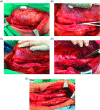Management of soft-tissue sarcomas; treatment strategies, staging, and outcomes
- PMID: 28287387
- PMCID: PMC5347369
- DOI: 10.1051/sicotj/2017010
Management of soft-tissue sarcomas; treatment strategies, staging, and outcomes
Abstract
Soft-tissue sarcomas (STS) are a rare group of malignant tumors which can affect any age group. For the majority of patients who present with a localized STS, treatment involves a multidisciplinary team decision-making approach ultimately relying on surgical resection with or without adjuvant radiation for successful limb salvage. The goals of treatment are to provide the patient with a functional extremity without local tumor relapse. The purpose of this article is to review the treatment of extremity STS, with a focus on staging, treatment options, and outcomes.
© The Authors, published by EDP Sciences, 2017.
Figures



References
-
- Siegel RL, Miller KD, Jemal A (2015) Cancer statistics, 2015. CA Cancer J Clin 65(1), 5–29. - PubMed
-
- Pollock RE, Karnell LH, Menck HR, Winchester DP (1996) The National Cancer Data Base report on soft tissue sarcoma. Cancer 78(10), 2247–2257. - PubMed
-
- Fletcher CD (2014) The evolving classification of soft tissue tumours – an update based on the new 2013 WHO classification. Histopathology 64(1), 2–11. - PubMed
-
- Gerrand CH, Bell RS, Wunder JS, Kandel RA, O’Sullivan B, Catton CN, Griffin AM, Davis AM (2003) The influence of anatomic location on outcome in patients with soft tissue sarcoma of the extremity. Cancer 97(2), 485–492. - PubMed
-
- Frassica FJ, Khanna JA, McCarthy EF (2000) The role of MR imaging in soft tissue tumor evaluation: perspective of the orthopedic oncologist and musculoskeletal pathologist. Magn Reson Imaging Clin N Am 8(4), 915–927. - PubMed
LinkOut - more resources
Full Text Sources
Other Literature Sources
